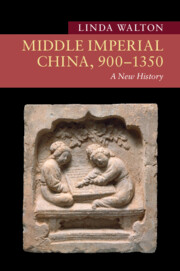Book contents
- Middle Imperial China, 900–1350
- New Approaches to Asian History
- Middle Imperial China, 900–1350
- Copyright page
- Dedication
- Contents
- Figures
- Maps
- Acknowledgments
- Introduction
- 1 The Turbulent Tenth Century
- 2 Song in a Multipolar World
- 3 Schooling, State, and Society in Song and Jin
- 4 An Economic Revolution?
- 5 Cities and Urban Life
- 6 Religious Transformations
- 7 Ways of Knowing
- 8 The Arts of Culture
- 9 Gendered and Generational Lives
- 10 Mapping the Built and Natural Environment
- 11 Sustaining Life and Healing Bodies
- 12 The Mongol Yuan Dynasty in China
- 13 Yuan China in the Mongol Eurasian Empire
- Bibliography
- Index
- New Approaches to Asian History
10 - Mapping the Built and Natural Environment
Published online by Cambridge University Press: 20 July 2023
- Middle Imperial China, 900–1350
- New Approaches to Asian History
- Middle Imperial China, 900–1350
- Copyright page
- Dedication
- Contents
- Figures
- Maps
- Acknowledgments
- Introduction
- 1 The Turbulent Tenth Century
- 2 Song in a Multipolar World
- 3 Schooling, State, and Society in Song and Jin
- 4 An Economic Revolution?
- 5 Cities and Urban Life
- 6 Religious Transformations
- 7 Ways of Knowing
- 8 The Arts of Culture
- 9 Gendered and Generational Lives
- 10 Mapping the Built and Natural Environment
- 11 Sustaining Life and Healing Bodies
- 12 The Mongol Yuan Dynasty in China
- 13 Yuan China in the Mongol Eurasian Empire
- Bibliography
- Index
- New Approaches to Asian History
Summary
Thephysical structures within which people lived, learned, prayed, and played – the “built environment”– were both technological accomplishments and expressions of cultural and social meaning. From imperial palaces to domestic residences, from schools, temples, shrines, monasteries, and tombs to theaters and shops, buildings were placed in urban or rural landscapes following the principles of geomancy (most notably tombs) and other religious traditions (monasteries on sacred mountains, for example) or responding to commercial and social needs (shops, restaurants, and theaters in urban centers). Buildings were also products of the natural environment, constructed from materials that were either readily accessible or affordable to buy. The natural environment was more than a source of building materials or a backdrop for human activity. Rivers, lakes, forests, and mountains, along with the geological makeup of the land and its soils, were features of the natural landscape experienced by human actors who utilized and managed them with varying degrees of success. Climate also was a powerful and often unpredictable force that people were dependent upon for survival. Geographic space as imagined and represented through mapping is an equally important approach to deciphering human activity in relation to the physical environment.
Keywords
- Type
- Chapter
- Information
- Middle Imperial China, 900–1350A New History, pp. 245 - 268Publisher: Cambridge University PressPrint publication year: 2023



